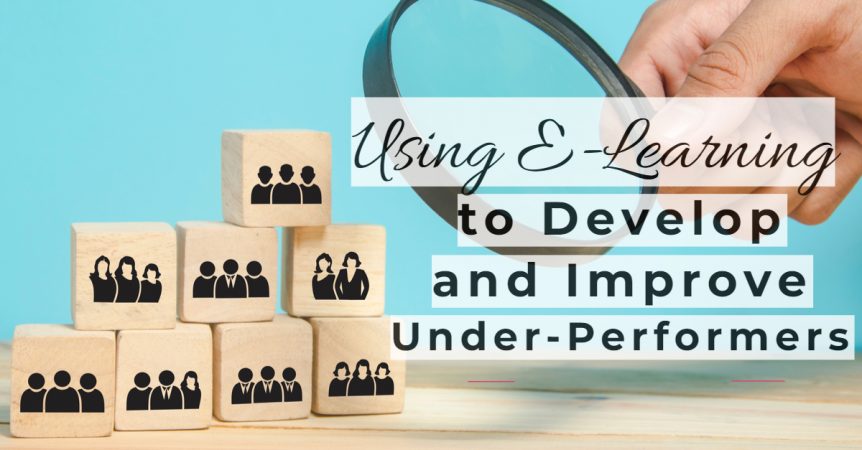Using E-Learning to Develop and Improve Under-Performers
The traditional approach when dealing with under-performers in an organisation is to get rid of them. There are times when this is appropriate, but it isn’t always the best approach. After all, many industries (including those in the UAE and Saudi Arabia) are facing a skills shortage where it is a challenge to recruit suitable employees. You also have to factor in the general cost of recruiting a new member of staff and paying them while they get up to speed.
In many situations, the best approach with under-performing employees is to take steps to improve their performance. Training will play an important role in this process, with e-learning being a highly effective training delivery strategy.
How do you develop e-learning courses that will improve the performance of under-performers? What are the pitfalls to avoid, and how can get you maximum return from your investment? How can you maximise the potential for success?
Is Poor Leadership the Real Issue?
Sometimes the root cause of under-performing employees is not the employees themselves, but the people who are leading them. If managers are not inspiring, developing, and motivating their teams, individuals may underperform. Therefore, you need to consider whether your real problem is under-performing employees, or do you have a leadership problem in your organisation.
The solution to a leadership problem will depend on your situation. Changing the leadership can produce an immediate performance gain, but this might not always be possible. Management and leadership training is another option.
Assess the Skills You Need to Improve
The starting point for developing under-performing employees is to identify the skills that are lacking. For example, does the employee need to upskill, or do they need to become better at a skill they already have? Both examples will require a different approach to training.
Make the Training as Engaging and Interesting as Possible
Employees going through this type of training might be nervous or apprehensive. These feelings are a barrier to engagement, but you can help break down this barrier by making the content as interesting, informative, relevant, and fun as possible.
Focus on the Problem, Not the Person
Performance management can often be overly negative, with personalised criticism. Try to avoid this when creating e-learning training content. A better approach is to focus on the problem you are trying to solve, i.e., the skill or skills that should be improved.
In general, it can be helpful to remember that people can be self-conscious and embarrassed when faced with their shortcomings. This is one of the reasons why e-learning is so beneficial for improving the performance of under-performers, as it is a private learning space.
Personalise the Training
Personalising your e-learning courses can help improve engagement with this type of training. The aim is to avoid as much as possible presenting information to employees that they are already familiar with, i.e., you should avoid giving training in areas where they are already skilled.
After all, even under-performing employees will have things they are good at. By lumping these things into the training along with everything else, you risk demotivating the employee and disengaging them with the training.
Use Scenarios
Scenarios can be a highly effective tool at improving performance, not least because it gives your employees a chance to practice in a safe, risk-free environment. In other words, they are able to make mistakes.
Don’t just let them make mistakes, though, as there should be explanations throughout the scenario explaining why each decision was right or wrong, good or bad. This ensures the employee understands where and how they are going wrong, helping them improve.
Consider Whether Competitive Elements Are Appropriate
Adding competition to your e-learning courses can be fun and motivational. For those who are struggling, however, competitive elements can have the opposite effect, i.e., they can be demoralising. Therefore, consider carefully whether competitive elements are appropriate or not.
If, on balance, you would prefer to include competitive elements, look at ways of levelling the playing field between those who are your star performers (who usually win everything) and those you want to improve. By giving under performers a chance to succeed in the e-learning course, you can encourage them to continue working to get better.
Don’t Forget About Strengths
The obvious thing to do when creating training to improve the performance of under-performers is to focus only on weaknesses. However, it is important to think about strengths too.
Firstly, there is a motivational factor, as people like to be praised when they are good at something. You might even be able to use an employee’s strengths to help them improve in the areas where they are weak.
The Flexibility of E-Learning
Other things you can do to improve the performance of under-performers in your organisation include assigning mentors and carrying out regular reviews to ensure the employee knows exactly where they stand. Training is essential, however, and not just because it will increase the skills of your under-performing employees.
Training also helps to increase engagement, and it establishes a mindset of continuous improvement. When you use e-learning as the training delivery method, you also have an opportunity to personalise the training content to make it as relevant as possible to individual learners, giving them every chance to develop and grow.
